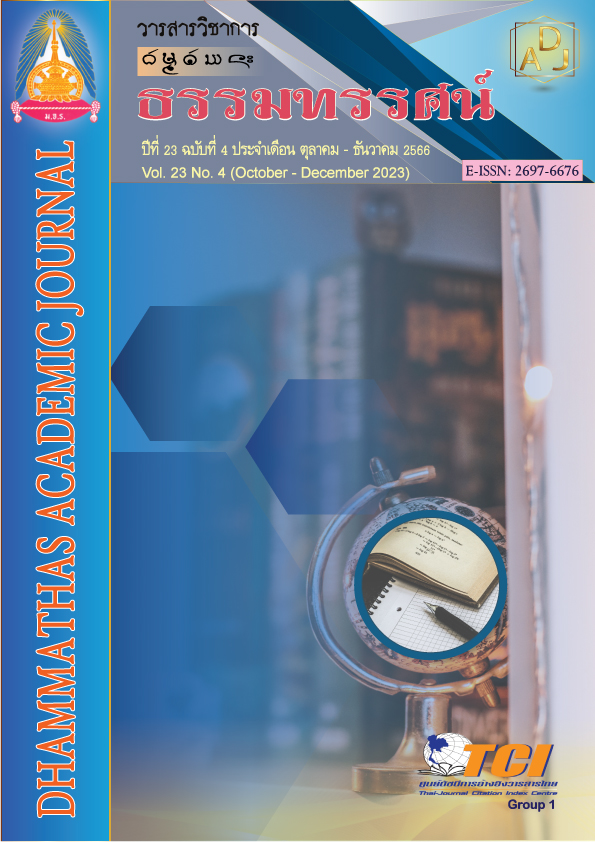Integrating Buddhist Arts into the Community
Main Article Content
Abstract
This research article the objective is to integrate Buddhist arts into the community. This project is Mixed Method. Population groups distributed in the upper northern region include 1) Ban Sam Kha community, Mae Tha district, Lampang province. 2) Doi Suthep community, Mueang district, Chiang Mai province. 3) Ban Ram Poeng community, Mueang district, Chiang Mai province. 4) Community Thara Thip Chai Pradit Temple, Mae Taeng District, Chiang Mai Province. 5) Pa Tum Don Community, Phrao District, Chiang Mai Province. 6) Mae Hang Community, Wiang Ka Long Subdistrict, Wiang Pa Pao District, Chiang Rai Province. Analyze data from document and field data collection by processing all received information and analyze the content according to the descriptive research objectives.
The research found that: Integrating Buddhist arts into the community brings benefits to the community in many ways, such as unity and pride academic progress Economic prosperity, faith, and sustainability of Buddhism, etc. Both integration with the community requires the community to participate in every step of the operation. To allow the community to feel ownership of the Buddhist art that is created. Designing Buddhist art works in that community it should be a traditional work in the community. It is work that people in the community have the expertise to create. It is work that used to exist but has not been passed down. It is an event where people in the community respect and believe in Buddhist art. Research tools include physical records and structured interviews.
Article Details

This work is licensed under a Creative Commons Attribution-NonCommercial-NoDerivatives 4.0 International License.
เพื่อให้เป็นไปตามกฎหมายลิขสิทธิ์ ผู้นิพนธ์ทุกท่านต้องลงลายมือชื่อในแบบฟอร์มใบมอบลิขสิทธิ์บทความ ให้แก่วารสารฯ พร้อมกับบทความต้นฉบับที่ได้แก้ไขครั้งสุดท้าย นอกจากนี้ ผู้นิพนธ์ทุกท่านต้องยืนยันว่าบทความ ต้นฉบับที่ส่งมาตีพิมพ์นั้น ได้ส่งมาตีพิมพ์เฉพาะในวารสาร วิชาการธรรม ทรรศน์ เพียงแห่งเดียวเท่านั้น หากมีการใช้ ภาพหรือตารางของผู้นิพนธ์อื่นที่ปรากฏในสิ่งตีพิมพ์อื่นมาแล้ว ผู้นิพนธ์ต้องขออนุญาตเจ้าของลิขสิทธิ์ก่อน พร้อมทั้ง แสดงหนังสือที่ได้รับการยินยอมต่อบรรณาธิการ ก่อนที่บทความจะได้รับการตีพิมพ์References
ชุลีกร ลิ่งไธสง และคณะ. (2563). การศึกษาผลกระทบภายหลังการติดเชื้อไวรัสโคโรนา 2019 (COVID-19) ของบุคลากรสถาบันพัฒนาสุขภาวะเขตเมือง. (รายงานการวิจัย). กรุงเทพฯ: กลุ่มงานพัฒนาวิจัย นวัตกรรมและความรอบรู้ด้านสุขภาพสถาบันพัฒนาสุขภาวะเขตเมือง.
ศักดิ์ชัย สายสิงห์. (2556). พระพุทธรูปในประเทศไทย รูปแบบ พัฒนาการ และความเชื่อของคนไทย. กรุงเทพฯ: ภาควิชาประวัติศาสตร์ศิลปะ คณะโบราณคดี มหาวิทยาลัยศิลปากร.
ศิริศักดิ์ อภิศักดิ์มนตรี. (2563). วิหารกลุ่มชาติพันธุ์ไตในล้านนา: การสร้างสรรค์เส้นทางและรูปแบบการท่องเที่ยวใหม่. (รายงานการวิจัย). กรุงเทพฯ: กรมส่งเสริมวัฒนธรรม กระทรวงวัฒนธรรม.
_______. (2566). พุทธศิลป์ล้านนา: รูปแบบ แนวคิด และการวิเคราะห์. เชียงใหม่: สแกนเนอร์.

